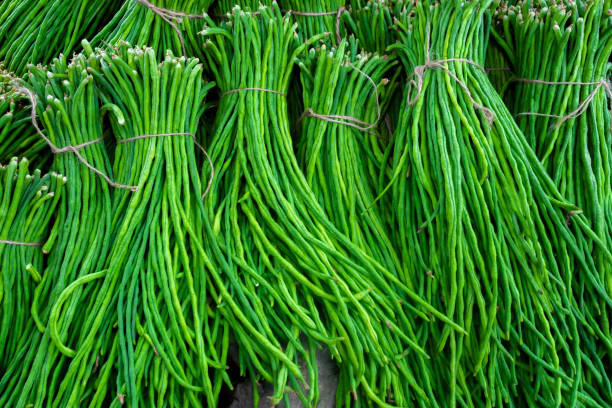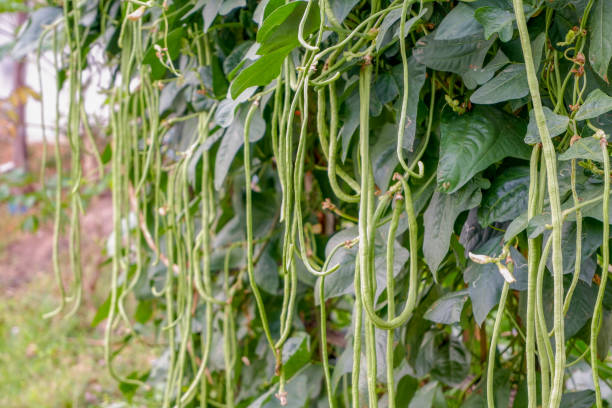

Vigna unguiculata (L.) Walp.
|
Cowpea, commonly known as Lobiya, belonging to the family Fabaceae, is one of the most widely used legumes in the tropical countries with high protein content. Presence of bioactive compounds like α-Tocopherol, Caffeic acid, α-Carotene, β-Carotene, Catechin 7-O-glucoside, Vanillic acid, Kaempferol-3-O-diglucoside, and Lycopene etc. are noted. The cowpea extracts down regulates pro-inflammatory cytokines (IL-8, TNF-α, VCAM-1), transcription factor NF-κB. Additionally, cowpeas are also rich in threonine which assists boosting of immune system by promoting the antibodies. Mode of Consumption : Fried and boiled |
| Plant Details | Agro-climatic Zone | Vernacular Names | Pictures |
| Scientific Name: Vigna unguiculata (L.) Walp. Family: Fabaceae Lindl. Class: Magnoliopsida Order: Fabales Genus: Vigna Savi. Fruiting Season: July-January Parts: Fruit |
|
Andhra Pradesh : Alasandalu, Kaaraamanulu Assam : Boodee, Dang Boodee Karnataka : Alasabde, Alasundi Maharashtra : Alasunda, Chavali Manipur : Hawai asangbi, Pong hawai Mizoram : Be-hlawi Tamil Nadu : Kaattu ulundu, Karamani West bengal : Ghangra |
 Fruit bundles  Plant |
| Compound/Extract | Activity | Mode of Action | Marker/References |
| Cowpea extract | Anti-inflammatory | The cowpea extracts down regulated pro-inflammatory cytokines (IL-8, TNF-α, VCAM-1), transcription factor NF-κB and modulated microRNA-126. | (IL-8, TNF-α, VCAM-1, and NF-κB[2] |
| Major Class | Metabolites (Content of bioactives: mg/100g Fresh Weight) |
| Alkaloid | Caffeine: , Theobromine: [6] |
| Amino Acid | Cysteine: 840-1080 mg/100g, Histidine: 1850-2470 mg/100g, Isoleucine: 4170-5460 mg/100g, Leucine: 6450-8500 mg/100g, Lysine: 7300-8740 mg/100g, Methionine: 1280-2060 mg/100g, Threonine: 3890-5120 mg/100g, Tryptophan: 1000-1330 mg/100g[1] |
| Carboxylic Acid | Caffeic acid: 0.1 mg/100g, cis-Ferulic acid: 0.12 mg/100g, Gallic acid: 0.02 mg/100g, p-Hydroxybenzoic acid: 0.45 mg/100g, Protocatechuic acid: 0.36 mg/100g, trans-Ferulic acid: 0.62 mg/100g, Vanillic acid: 0.25 mg/100g[3] |
| Carotenoid | Lutein: , Lycopene: , Zeaxanthin: , α- Carotene: 0.055 mg/100g, β- Carotene: 0.794 mg/100g, β-Cryptoxanthin: [6] |
| Cinnamic acid derivative | trans-Feruloylaldaric acid: 2.25 mg/100g, trans-Feruloyl-methylaldaric acid: 0.61 mg/100g, trans-p-Coumaric acid: 0.09-0.36 mg/100g, trans-p-Coumaroylaldaric acid: 1.22 mg/100g[3] |
| Flavonoid | Catechin: 1.7-29.7 mg/100g, Kaempferol-3-O-diglucoside: 3.87 mg/100g[3] |
| Flavonol | Catechin 7-O-glucoside: 77-255.3 mg/100g, Quercetin 3-O-digalactoside: 0.11-4.85 mg/100g, Quercetin 3-O-diglucoside: 1.61-334 mg/100g, Quercetin 3-O-galactosylglucoside: 1.25-31.4 mg/100g, Quercetin 3-O-glucoside: 0.09-1.53 mg/100g[3] |
| Phenolic compound | cis-p-Coumaric acid: 0.01 mg/100g[3] |
| Phenols | Protocatechuic aldehyde: [3] |
| Vitamin | Phylloquinone: 0.0315 mg/100g, α-Tocopherol: [6] |
| Effect | Observation | DOI |
| Disease | Formulation | Reference | Author | TKDL |
| Beneficial for throat, Cardio-tonic, oral cavity, Rheumatism | Saptamushtikayusha | Sharangadhara Samhita | Written by Sharangadhara charya, Translated by Smt. Shailaja Srivastava | Ayurveda |
| Indigestion, Ascites, Enlargement of spleen, Pain, in Chest, Tenesmus | Pirandai Vadagam | Therayar Sekarappa | Therayar | Siddha |
| All types of Colic, Pleurodynia and intercostal neuralgia, Pain, in Hand, Leg, Abscess, Scrofula/Cervical lymphadenitis, Leprosy and other dermatoses, Abscess, Leprosy and other dermatoses, Scabies, Itch, Alopecia, Urticaria/Allergic rashes, Cancer/ Carcinoma, Cancer/ Carcinoma, or Scrotum, Non-healing ulcer, Syphilis, Cervical erosion with ulcer, Ulcer/Wound, Gangrenous stomatitis/Cancrum oris, Diabetic furuncle, Perineal fistulas, Piles/Haemorrhoids. | Rasaganthi Mezhugu | Pulippani Vaithyam - 500. | Written by Pulippani; Edited by S.P.Ramachandhiran | Siddha |
| Information from Wealth of India | Reference |
|
CSIR(1976).The Wealth of India, Raw materials,Vol.-X ,P.497-510, New Delhi, India |
| 4.2, 4.2.1, 4.2.1.1, 4.2.1.2, 4.2.1.3, 4.2.2.8 |
| CSIR-North East Institute of Science and Technology, Jorhat-6, Assam, India
CSIR-Institute of Himalayan Bioresource Technology, Palampur-61,Himachal Pradesh, India |